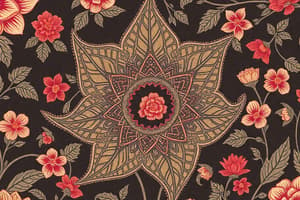Podcast
Questions and Answers
What is the purpose of vascular tissue in plants?
What is the purpose of vascular tissue in plants?
- Facilitates water and nutrient transport (correct)
- Stores excess sugars
- Aids in seed dispersal
- Produces oxygen through photosynthesis
Which process involves the production of glucose using sunlight, water, and carbon dioxide?
Which process involves the production of glucose using sunlight, water, and carbon dioxide?
- Chromatography
- Cellular respiration
- Mitosis
- Photosynthesis (correct)
What is the main function of flower structures in plants?
What is the main function of flower structures in plants?
- Anchoring the plant in the soil
- Photosynthesis
- Storage of excess water
- Reproductive purposes (correct)
Which animal group is characterized by having an exoskeleton and jointed appendages?
Which animal group is characterized by having an exoskeleton and jointed appendages?
What is the term used to describe the alternating sexual and asexual generations in plants?
What is the term used to describe the alternating sexual and asexual generations in plants?
Which organelle is responsible for cellular respiration in animals?
Which organelle is responsible for cellular respiration in animals?
Which of the following is a defining characteristic of invertebrate animals?
Which of the following is a defining characteristic of invertebrate animals?
What is the purpose of the body cavity in animals?
What is the purpose of the body cavity in animals?
How do plant roots contribute to the process of photosynthesis?
How do plant roots contribute to the process of photosynthesis?
In animal diversity, what distinguishes vertebrates from invertebrates?
In animal diversity, what distinguishes vertebrates from invertebrates?
What is the primary function of stems in plants?
What is the primary function of stems in plants?
Which animal group is characterized by having an open circulatory system?
Which animal group is characterized by having an open circulatory system?
Flashcards
What is Photosynthesis?
What is Photosynthesis?
The process by which plants use sunlight, water, and carbon dioxide to create glucose (sugar) for energy.
What is an exoskeleton?
What is an exoskeleton?
A hard outer covering that protects and supports the bodies of arthropods.
What is a body cavity?
What is a body cavity?
The fluid-filled space within the body of many animals that provides support, cushions organs, and helps with circulation.
What is xylem?
What is xylem?
Signup and view all the flashcards
What is phloem?
What is phloem?
Signup and view all the flashcards
What is alternation of generations?
What is alternation of generations?
Signup and view all the flashcards
What is mitochondria?
What is mitochondria?
Signup and view all the flashcards
What are invertebrates?
What are invertebrates?
Signup and view all the flashcards
What is the role of petals in a flower?
What is the role of petals in a flower?
Signup and view all the flashcards
What are stamens?
What are stamens?
Signup and view all the flashcards
What is the pistil?
What is the pistil?
Signup and view all the flashcards
What is an open circulatory system?
What is an open circulatory system?
Signup and view all the flashcards
Study Notes
Vascular Tissue in Plants
- Transports water and nutrients throughout the plant.
- Xylem carries water upward from roots to leaves.
- Phloem carries sugars (produced during photosynthesis) from leaves to other parts of the plant.
Photosynthesis
- Process where plants use sunlight, water, and carbon dioxide to produce glucose (sugar) for energy.
- Takes place in chloroplasts, which contain chlorophyll.
Flower Structures
- Primarily involved in reproduction.
- Petals attract pollinators.
- Stamens produce pollen.
- Pistil contains the ovary, which houses the ovules.
Arthropods
- Belong to the phylum Arthropoda.
- Characterized by exoskeletons (hard outer coverings) and jointed appendages.
- Examples include insects, spiders, crustaceans.
Alternation of Generations
- Describes the life cycle of plants, alternating between a haploid (gametophyte) and a diploid (sporophyte) generation.
- The gametophyte produces gametes (sperm and egg), while the sporophyte produces spores.
Mitochondria
- Organelles found in animal cells, and most other eukaryotic cells.
- Responsible for cellular respiration, breaking down glucose to produce energy (ATP).
Invertebrates
- Lack a backbone (vertebral column).
- Make up the vast majority of animal species.
- Examples include insects, worms, mollusks, and crustaceans.
Body Cavity
- Fluid-filled space within the body that provides support, cushions organs, and aids in circulation.
- Found in most animal groups, such as annelids, arthropods, and vertebrates.
- Provides space for organ development and movement.
Plant Roots and Photosynthesis
- Roots absorb water and minerals from the soil.
- Water is transported through the xylem to leaves, providing the necessary component for photosynthesis.
Vertebrates vs. Invertebrates
- Vertebrates have a backbone (vertebral column).
- Invertebrates do not have a backbone.
- Vertebrates include mammals, birds, reptiles, amphibians, and fish.
Stem Functions
- Support the plant and hold leaves up for maximum sunlight absorption during photosynthesis.
- Transport water and nutrients between roots and leaves.
Open Circulatory System
- Blood flows through a system of open spaces (hemocoel) rather than enclosed vessels.
- Characteristic of arthropods such as insects, crustaceans, and arachnids.
- Allows for efficient movement of blood in smaller, less active animals.
Studying That Suits You
Use AI to generate personalized quizzes and flashcards to suit your learning preferences.




